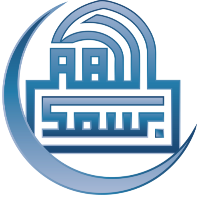The following shows the text of the first Sura’ of the Qur’an inscribed on the shoulder blade of a camel, preserved in the Princeton University Library.1


We know that the first steps for the preservation of the Qur’an were taken in the lifetime of the Prophet. Tradition records that the Qur’an — in addition to being memorized — was also written down on such shoulder-blades, ribs of animals, flat stones, palm-leaves, pieces of leather and wooden boards.
However, in addition to the use of all this material, there is no reason why papyrus should not have been in normal use in the business & private correspondence in Mecca, and hence for the recording of the Qur’anic revelations. In 6:91, the Qur’an refers to the Torah (with the Arabian Jews) to be recorded on “Qartas”. This word refers to a leaf or sheet of papyrus made in rectangular sheets, pasted together or folded to form a book.
In 6:92, the Qur’an speaks of itself in exactly the same sense (i.e., written on “Qartas”), as it referred to the Torah in the previous verse.
Dr. M. M. Azami2 mentions 48 persons who used to write for the Prophet, among whom Zayd bin Thabit was very prominent.




5 Comments
The original Quran was written in tangible materials like bones, leaves, stones etc… Original in the sense that this is the first written quranic materials.
So logically, this is the original quran. And most probably, it was lost as stated :
Ibn Abi Dawud, Kitab al-Masahif — Many (of the passages) of the Qur’an that were sent down were known by those who died on the day of Yamama … but they were not known (by those who) survived them, nor were they written down, nor had Abu Bakr, Umar or Uthman (by that time) collected the Qur’an, nor were they found with even one (person) after them.
What could be concluded from this reality ?
We know that Quran transmission was too by oral recitation (memorizers). But the original reciters were dead so there is no way to validate if quran was preserved by recitation. There is no way we can compare modern recitation to the original.
We know also that the original written quran (on leaves, bones, stones etc…) were lost so there is no way we could determine the authenticity of modern Quran. We have no way to compare modern quran to the original as it was lost.
So there goes the problem.
Where is the guarantee that the original message of Allah is preserved if there is no way to establish the authenticity of the modern quran ?
Much so, of the 26 different quran, which one is real ?
Logically, it cannot be determined seeing that there is no original quran (or original reciters) to validate anything.
Therefore, Muslims, your faith is established upon uncertainties. So ask yourselves :
Is there any real quran ?
The answer to your infantile question is that the Quran was preserved not only in writing but also through memorization and a master copy was kept in the house of Hafsa’, the wife of the Prophet PBUH. Thousands memorised the Qur’an and it was never wiped from memory. Plus you lie when you say that there are “26 Qurans”. No such thing exists. There has always been ONE Quran.
Not quite as amazing as the Shroud or Turin, though perhaps as authentic (i.e. highly questionable).
Apparently this is the rough equivalent to the divination of where antelope can be found using antelope bones heated over fire.
Habakkuk 3:17 – 19 ; Song of Songs 2:7 ; Revelation 22:17
BTW : Is it actually life-giving to read books written on bones ?
I prefer to read the New Testament on paper & then to listen to Jesus.
Thanks for showing this, very interesting. A literal translation of the text wd be helpful for people like me who are weak in Arabic, and an analysis of any differences from what one wd fine in Yusuf Ali’s Arabic text seems essential.
Brother, do you have links to more picture such as the one in this article ? Jazak Allah Khair.